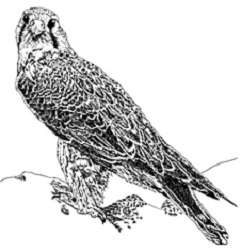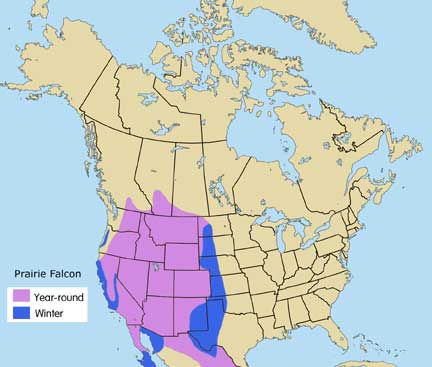
Scientific Name: Falco mexicanus
Prairie Falcons are slimmer and longer-tailed than Peregrine Falcons, and also more active, nervous and aggressive in behavior. Females are larger than males, but the sexes have similar plumages. Upperparts are a gray-brown, with light edges along many of the back feathers; the tail is brown with a white tip, and barring along the outer tail feathers. The throat and underparts are whitish with brown, elongated spots. The top and sides of the head are dark; the face has a light eyebrow, a white cheek, and a narrow brown mustache stripe. When seen in flight from below, dark triangles are visible on the inner portion of pale wings (“dirty armpits”) – a feature not seen on any other North American falcon. Prairie Falcons fly with shallow, stiff, powerful wingbeats, and soar on flat wings with the tail slightly fanned. These falcons often fly low and fast over the ground in pursuit of prey.
Male
Length: 14 – 16″
Wingspan: 36 – 38″
Weight: 0.9 – 1.4 lb.
Female
Length: 16 – 18″
Wingspan: 41 – 44″
Weight: 1.5 – 2.1 lb.
State and federally protected.
Prairie Falcons are found on open prairies and rangelands of the inland arid western states; from low elevations up to 1,200 feet, wherever there are rocky outcrops or bluffs nearby for nesting; they tolerate both heat and cold. This species doesn’t need to breed near water, unlike the Peregrine Falcon, and so can use areas not suited to that other large falcon. Not usually found in coastal areas. A few nest west of the Cascades, but are more likely to be seen in the Willamette Valley in winter.
Prairie Falcons prefer to capture prey on the ground, unlike their Peregrine Falcon cousins. Small to medium sized mammals and ground-dwelling birds form the bulk of their diet, with snakes, lizards, and flying insects taken as well. These birds like to hunt from a perch, course until flushing prey and then putting on a burst of speed, dive down from soaring flight to chase prey by flying low to the ground, or hover hunt like the American Kestrel.
Alarm call is a harsh ree-kree-kree-kree-kree; also a rising, repeating scream of keeekeeekeee – higher in pitch than the calls of the Peregrine Falcon.
Nests high on rock ledges, bluffs, or cliffs – high enough to avoid ground predators, but usually not at cliff tops. Make a shallow scrape for eggs. They also use old nests of other bird species.
Tangling in fences, gunshot, collisions.

Western North America from British Columbia to central Canada, south down to Mexico. Migratory over the northernmost part of their range, but in most areas they remain throughout the year, even in Canada.
Special Thanks for range maps:
Dan Gleason
BGleason Design & Illustration
Commercial & Scientific Illustration, Graphic Design
CraneDance Communications
Book Production/Design

